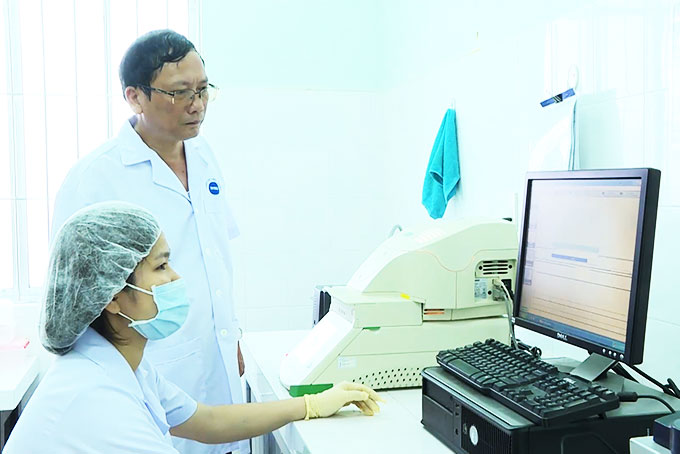
Microsporidian Enterocytozoon hepatopenaei (EHP) detection by using Real-time Polymerase Chain Reaction (PCR) method was highly appreciated and awarded the second prize...
Microsporidian Enterocytozoon hepatopenaei (EHP) detection by using Real-time Polymerase Chain Reaction (PCR) method was highly appreciated and awarded the second prize at Khanh Hoa Scientific & Technical Creation Contest 2018-2019.
In recent years, the shrimp farming industry has faced an increasingly complex and damaging epidemic due to Microsporidian Enterocytozoon hepatonaei which was first found and identified in Thailand. However, the shrimp mortality rate due to EHP was low, so little concern was paid at that time. Now, the EHP infection has spread, causing massive economic losses in shrimp farming in particular and aquaculture in general. There is no specific clinical sign of EHP infection, so it is difficult to monitor the presence of EHP and manage affected shrimp farms, according to PhD Vu Khac Hung, Institute of Veterinary Research & Development of Central Vietnam (IVRD).

|
A group of researchers, namely PhD Vu Khac Hung and M.A Nguyen Xuan Truong, IVRD, has conducted a research on shrimp EHP detection procedure by using Real-time Polymerase Chain Reaction (PCR) method. This is a solution developed from the result of a Ministry-level research on Microsporidian Enterocytozoon hepatonaei in shrimp in brackish water.
The research aims to develop the PCR method, which has proved to be efficient and cost-effective compared with other shrimp EHP detection methods. After 6 months, the groups of researchers have completed a new creative diagnosis procedure, first applied in Vietnam. Accordingly, the group has improved the composition of the reaction and the thermal cycle, thereby contributing to saving materials and chemicals, increasing process stability compared to similar processes. At the same time, this improvement can extend applications on many different diagnostic device models as well as types of samples. It can be applied in early diagnosis of EHP in shrimp from its Nauplius first larval stage.
Especially, this process does not use materials, equipment, chemicals, electricity and water in the electrophoresis step, so it cuts costs and save time for testing with faster results and higher diagnostic productivity for multiple samples, allowing early disease detection before outbreaks, limiting epidemic spread and adverse environmental impacts. In addition, the procedure can be applied to samples of shrimps, shrimp larvae, fish, planktons and others suspected of being infected with EHP in any diagnostic rooms and laboratories equipped with real-time PCR. This result is very important in the disease diagnosis and prevention, thereby, helping farmers to proactively decide the suitable time for stocking, harvest and transportation to reduce economic losses.
According to PhD Vu Khac Hung, the detection method of EHP using real-time PCR has been recognized as a technical advancement by the Ministry of Agriculture & Rural Development. It has been applied by some institutions, namely National Centre for Veterinary Diagnosis, Department of Animal Health, Department of Animal Health region II, III, IV and V.
In Khanh Hoa, the procedure has been applied by Khanh Hoa Sub-Department of Livestock Production & Animal Health and Nha Trang University’s Center for Aquatic Animal Health & Breeding Studies. In 2017 and 2018 after the Real-time PCR was efficiently applied in shrimp farming, traditional histology method has been replaced by Real-time PCR in EHP detection, contributing to improving shrimp farming productivity, says Tran Vi Hich, Director of Nha Trang University’s Center for Aquatic Animal Health & Breeding Studies.
Khanh Ha
Translated by N.T










